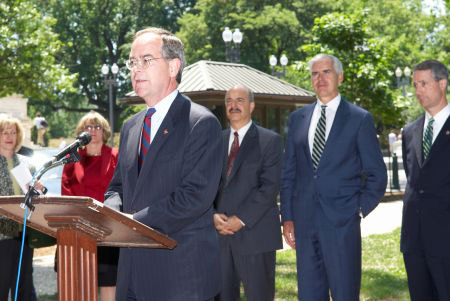Public Option Still a Sticking Point in Health Care Debate
Liberal Democrats have insisted the option be included to keep private companies honest, while Republicans have insisted that it be scrapped to ensure the viability of the private marketplace.
Jul 31, 2020238.6K Shares3.4M Views
Rep. Jim Cooper (D-Tenn.) (cooper.house.gov)
It’s become a predictable sticking point surrounding the Democrats’ hopes to revamp the nation’s health care system: The creation of a government-backed insurance planas an affordable alternative to private coverage.
Liberal Democrats have insisted the option be included to keep private companies honest, while Republicans have insisted that it be scrapped to ensure the viability of the private marketplace. Yet as liberal Democratic leaders continue to haggle with their conservative colleagues over the public-plan strategy, the entrenchment of black-and-white ideology has slowed the process to a crawl. In the eyes of an increasing number of health care experts and key lawmakers, agreeing to some tint of gray will be the only way to break the stalemate.
Illustration by: Matt Mahurin
“There are different ways to do this,” Rep. Jim Cooper (D-Tenn.), a member of the conservative-leaning Blue Dog Democrats, told CNN Tuesday. “So many advocates of public option don’t really know specifically what they’re advocating and so many opponents don’t really know what they’re opposing. So it’s important that we get the definition right.”
On its surface the concept is simple: A government-backed insurance plan offered alongside the private options would pressure those companies to keep coverage comprehensive, denials to a minimum and costs low. Supporters point out that the federal plan wouldn’t have to buy expensive advertising like other insurers, nor would it have to earn the profits expected by shareholders of private companies — money that could be used instead to reduce premiums.
On Tuesday, President Obama reiterated his support for the public plan as one option on a proposed menu of insurance plans which patients could choose from. “That helps keep the insurance companies honest, because now they have somebody to compete with,” Obama said during an online health care forum sponsored by AARP.
Two Democratic proposals already moving through Congress — one crafted by House leaders and the other by Democrats on the Senate health committee — include such an option.
But critics maintain that the public option would have an unfair, taxpayer-backed advantage over private plans that could eventually lead to the demise of private insurers altogether. The issue has pitted Democrats against Republicans, turned moderate Democrats against their liberal colleagues, and left the Obama administration straddling the chasm in search of a compromise capable of winning bipartisan support.
There are several proposals floating around Capitol Hill that could represent the compromise needed to push the Democrats’ sweeping health reform plans through the Senate, where 60 votes will be required to defeat a likely Republican filibuster. One would allow for the creation of a public plan only in areas where private insurers failed, after a set time period, to meet certain coverage and cost targets. The strategy has been blasted from the right for proposing a public option at all, while the left has criticized it for relying on the efficiencies of the same private model that’s left more than 45 million Americans uninsured.
Republicans are fond of citinga study by the Lewin Group indicating that the public plan, depending on how it’s modeled, could entice 119 million people to drop their private coverage. On Monday, however, the Congressional Budget Office released estimatesindicating that only between 11 million and 12 million people would choose the public option under the Democrats’ proposals.
Another compromise proposal would create regional co-operative plans to be managed by the same people buying into them. But that strategy, too, has been attacked from both sides of the ideological divide. Liberals point out that the patient pools would be much smaller in regional co-ops, eliminating the advantage of a nationwide plan to lower costs by virtue of its sheer size. Conservatives, meanwhile, argue that it would take an enormous government effort to get the co-ops up and running.
Cooper, for his part, has broken with many of the Blue Dogs to come out in support of the public-plan option — if it’s shown to cut the long-term health spending projections that are largely the inspiration for health reform to begin with. The Tennessee Democrat says he’s outlined 18 separate public-plan models that could serve that purpose.**
“There are types of a public plan that can work as long as it’s on a level playing field,” he told CNN.
The comments arrive as the Democrats’ plans to pass health care reform before the August recess seem increasingly out of reach. In the House, Democratic leaders of the Energy and Commerce Committee met with the Blue Dogs Tuesday to iron out their differences over a plan to link public-option rates to Medicare payments — a model that many moderates contend could restrict health care treatments in rural, already under-served parts of the country. But those negotiations, thus far, have led only to promises of more negotiations.
Meanwhile, all eyes remain trained on the Senate Finance Committee, where Chairman Max Baucus (D-Mont) has been huddled with five other members from both parties in search of the elusive health reform blueprint capable of bipartisan support. Early reports on those negotiations indicatethat the group is leaning toward scrapping the public option in favor of the co-op model.
On Tuesday, House Majority Leader Steny Hoyer (D-Md.) floated the possibility that House Democrats would accept the co-op strategy if it were structured to accomplish the same goals of covering the uninsured and lowering costs that the public plan is designed to tackle. “After all, a co-op will be a competitor,” Hoyer told reporters.
That, however, would be sure to incite a backlash from liberals,who had something different in mind when they went to the polls last November.
All sides of the debate agree that inaction on health care reform is no option. Under current models, health care spending nationwide is projected to rise by at least 6.2 percent annually over the next decade — more than 2 percentage points faster than the rest of the economy, according to the latest estimatesfrom the Health and Human Services Department.
It’s an unsustainable trend. As a share of the economy, health care spending stood at 16.2 percent in 2007, but is projected to reach 17.6 percent this year, topping 20 percent by 2018. Despite all the spending, roughly one in six Americans lacks health coverage.
“We spend a lot of money in our health care system that doesn’t do a thing to improve people’s health, and that has to stop,” Obama said at the AARP forum. “We’ve got to get a better bang for our health care dollar.”
**Update: Cooper’s office has declined to release this list, saying that it’s “outdated.”

Rhyley Carney
Reviewer
Latest Articles
Popular Articles

